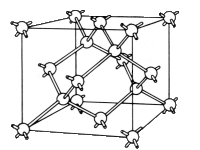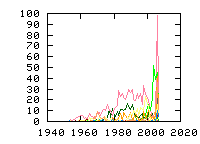« Previous
1
Next »
(5 hits, 1/1)
Showing
10, 25, 50, 100, 500, 1000, all papers per page.
Sort by:
last publication date,
older publication date,
last update date.
- 1. Appl. Phys. Lett. 85, 3780 (2004) , “Low temperature annealing of electron irradiation induced defects in 4H-SiC”, Antonio Castaldini, Anna Cavallini, Lorenzo Rigutti, Filippo NavaLow temperature annealing of electron irradiation-induced deep levels in 4H-SiC is reported. The major deep level transient spectroscopy peak S2 associated with the energy level at Ec–0.39 eV disappears in the temperature range 360–400 K, and some rearrangement... (Read more)
- 2. Nucl. Instrum. Methods Phys. Res. B 170, 125-133 (2000) , “Electron Paramagnetic Resonance Study of S2 Defects in Hydrogen-Implanted Silicon”, B. Rakvin, B. Pivac, R. Tonini, F. Corni and G. OttavianiElectron paramagnetic resonance spectra of S2 paramagnetic center in Float zone silicon (FZ-Si) and Czochralski silicon (CZ-Si) produced by H+2 ion-implantation and by subsequent annealing have been studied. At room temperature the spectrum exhibits an isotropic line g=2.0066±0.0002, which,... (Read more)
- 3. Jpn. J. Appl. Phys. 12, 1307 (1973) , “ESR Studies on Defects and Amorphous Phase in Silicon Produced by Ion Implantation”, K. Murakami, K. Masuda, K. Gamo, S. Namba.Paramagnetic defects have been studied over a wide dose range. At doses>6×1014 P+/cm2, only one isotropic spectrum of g=2.0062±0.0004 which characterizes a continuous amorphous layer is observed. At doses between 0.1 and... (Read more)
- 4. J. Appl. Phys. 43, 3499-3506 (1972) , “Electron Paramagnetic Resonance of the lattice Damage in Oxygen-Implanted Silicon”, K.L. Brower and Wendland BeezholdThe nature of the lattice damage produced at room temperature in ion-implanted intrinsic and n-type silicon has been studied as a function of 160-keV O+ ion fluence using electron paramagnetic resonance (EPR). The known EPR spectra observed were the negative divacancy (Si-G7), the... (Read more)Si| EPR ion-implantation neutron-irradiation| 31P D G7 Oxygen P3 Phosphorus S1 S2 SL2 Silicon amorphous vacancy .inp files: Si/SL2 | last update: Takahide Umeda
- 5. Phys. Lett. A 25, 726 (1967) , “Die bildung paramagnetischer zentren längs der reichweite von protonen in silizium”, H. Lütgemeier and K. SchnitzkeA new isotropic center S2 is observed at the end of the range of photons in silicon. By etching the irradiated samples in steps of a few microns, the dependency of the production rate of the centers S1, S2, P1 and P3 was investigated. (Read more)
« Previous
1
Next »
(5 hits, 1/1)
Showing
10, 25, 50, 100, 500, 1000, all papers per page.
Sort by:
last publication date,
older publication date,
last update date.
All papers (3399)
Updated at 2010-07-20 16:50:39
Updated at 2010-07-20 16:50:39
(view as: tree
,
cloud
)
| 1329 | untagged |
Materials
(111 tags)
Others(101 tags)
Technique
(46 tags)
Details
(591 tags)
Bond(35 tags)
Defect(interstitial)(18 tags)
Defect(vacancy)(15 tags)
Defect-type(19 tags)
Element(65 tags)
Energy(8 tags)
Isotope(56 tags)
Label(303 tags)
Sample(17 tags)
Spin(8 tags)
Symmetry(15 tags)

